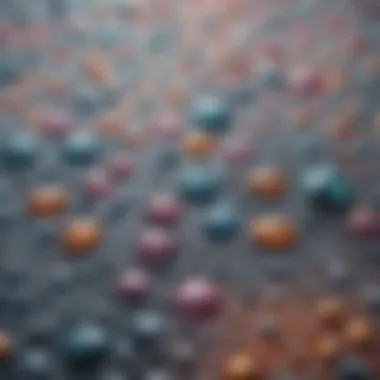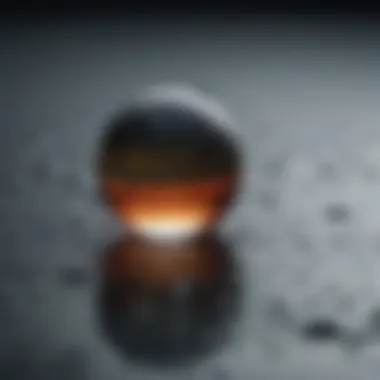Exploring Super Hydrophilic Materials and Their Applications


Intro
Super hydrophilic materials possess a unique affinity for water, enabling them to interact with it in sophisticated ways. These materials are defined by their ability to attract and hold water molecules, which results in various advantageous properties. Through an in-depth exploration, this article aims to unfold the intricate mechanisms that give rise to super hydrophilicity, and investigate their significance across different scientific and engineering disciplines.
The relevance of super hydrophilic materials is ever-increasing as industries seek innovative solutions to enhance functionality and improve sustainability. By examining key definitions, properties, applications, and future potential, this text serves to provide a comprehensive understanding of this captivating subject.
Research Overview
Summary of key findings
Super hydrophilic materials have shown promising capabilities in several domains such as biomedical applications, microfluidics, and environmental technologies. The main findings in research point towards an improved performance in water management, anti-fogging surfaces, and enhanced biological compatibility. These materials often exploit molecular mechanisms that allow for rapid water spreading and superior absorption, making them suitable for use in water filtration systems and drug delivery methods.
Importance of the research in its respective field
The studied properties of super hydrophilic materials carry significant weight within material science and engineering. They offer potential solutions to pressing global issues, such as clean water availability and energy-efficient processes. Understanding these materials can lead to innovations that improve both functionality and sustainability.
Methodology
Description of the experimental or analytical methods used
Research on super hydrophilic materials typically involves a combination of experimental approaches and analytical techniques. Synthesis methods vary widely, with popular techniques including sol-gel processes, chemical vapor deposition, and electrospinning. These methods allow for precise control over material properties, which is crucial for maximizing hydrophilic characteristics.
Sampling criteria and data collection techniques
In studies about super hydrophilic materials, sampling criteria significantly impact the accuracy of findings. Typically, researchers collect samples based on specific characteristics such as surface roughness, porosity, and chemical composition. Data collection often involves advanced imaging techniques like scanning electron microscopy (SEM) and atomic force microscopy (AFM), which provide crucial insights into the surface morphology and interaction with water molecules.
The exploration of super hydrophilic materials continues to present opportunities for technological advancement in various fields, emphasizing the need for ongoing research in the area.
Prelude to Super Hydrophilic Materials
Super hydrophilic materials are essential in numerous scientific and engineering domains. This section will explore their definitions, historical context, and their importance in modern applications. Understanding super hydrophilicity is crucial for advancements in material science.
Defining Super Hydrophilicity
Super hydrophilicity refers to the property of materials exhibiting an extremely high affinity for water. Such materials typically have water contact angles below 10 degrees, meaning water droplets spread freely on their surface. Unlike standard hydrophilic surfaces, super hydrophilic materials can absorb and manage water efficiently. This characteristic stems from the material's chemical composition, surface morphology, and the energy it releases upon water interaction.
Historical Context and Development
The exploration of super hydrophilic materials is not a recent development. The historical journey began in the early 20th century with the observation of various natural materials displaying hydrophilic properties. Studies on materials like lotus leaves highlighted how surface textures influence water interaction. Later, in the late 20th century, advances in polymer science and nanotechnology enabled the engineering of surfaces with tailored hydrophilic properties. Researchers began to synthesize super hydrophilic coatings and surfaces, which have since gained traction in diverse applications.
Importance in Modern Science
In contemporary science, super hydrophilic materials play a pivotal role across multiple sectors. They have significant applications in the medical field, particularly in drug delivery and biological implants where enhanced fluid interaction is desirable. In environmental science, these materials contribute to water purification and advanced filtration systems. Their inherent properties allow for innovative designs in textiles and coatings that resist dirt and promote cleanliness. The flexibility and adaptability of super hydrophilic materials make them valuable for ongoing research and future applications.
"Super hydrophilic materials bridge the gap between nature's design and human ingenuity, leading to remarkable innovations in diverse fields."
Understanding super hydrophilicity, its evolution, and its current applications is essential for grasping the future trajectory of material technology. As we progress, the potential for super hydrophilic materials to address pressing global challenges becomes clearer.
Fundamental Properties of Super Hydrophilic Materials
Understanding the fundamental properties of super hydrophilic materials is crucial for various applications and advancements in material science. Super hydrophilic materials exhibit an extraordinary affinity for water, leading to significant benefits in fields like medicine, environmental science, and textile engineering. These materials not only interact favourably with water but also facilitate processes such as self-cleaning and improved wettability. This section delves deeper into the specific elements that comprise these properties and their implications.
Chemical Composition
The chemical composition of super hydrophilic materials plays a vital role in determining their hydrophilicity. The most common elements found in these materials include oxygen, nitrogen, and silicon. These elements can form polar functional groups, such as hydroxyl (-OH) and amino (-N) groups, which are known to enhance water affinity.


In materials such as titanium dioxide or silica gels, the arrangement of their molecular structure allows water molecules to bond more readily. Such bonding is essential, as it influences the materials' effectiveness in various applications. The choice of materials also affects their stability and reactivity under different environmental conditions.
Physical Characteristics
Super hydrophilic materials present unique physical characteristics that distinguish them from regular materials. One important aspect is their surface roughness. Materials that possess micro or nanoscale textures exhibit enhanced hydrophilicity. The increase in surface area due to these textures allows for greater interaction with water, sometimes resulting in a phenomenon called Cassie-Baxter wetting, where water droplets spread rather than form beads.
In addition to surface roughness, the thickness of the material can influence its hydrophilicity. Thinner materials can exhibit superior wetting properties.
Overall, understanding these physical characteristics is paramount for engineers and scientists looking to optimize material performance in specific applications.
Surface Energy Measurements
Surface energy is a key parameter in defining the interactions between a solid and a liquid. In super hydrophilic materials, surface energy is predominantly high, leading to low contact angles for water droplets. Measuring surface energy helps in determining the wettability of materials.
Various methods are utilized to assess these properties, such as the Young-Laplace equation and contact angle goniometry. By understanding how surface energy affects material performance, researchers can design materials that meet precise hydrophilicity specifications.
High surface energy materials typically exhibit contact angles less than 10 degrees, indicating very strong attraction to water.
Mechanisms of Super Hydrophilicity
Understanding the mechanisms underlying super hydrophilicity is vital to grasp how these materials interact with water. This section explores the various elements that contribute to an enhanced affinity for water molecules. The specific mechanisms allow researchers to develop materials with tailored properties for targeted applications, optimizing their performance in real-world scenarios.
Molecular Interactions
Molecular interactions are fundamental in determining the hydrophilic behavior of materials. They primarily occur between water molecules and the surface of super hydrophilic materials. Hydrogen bonds play a crucial role in this context. When a water droplet contacts a super hydrophilic surface, the polar nature of water molecules leads to the formation of hydrogen bonds with functional groups present on the surface. This bonding strength significantly reduces the contact angle, causing water to spread effectively across the surface.
It's also noteworthy that electrostatic interactions contribute to the wetting properties of these materials. For instance, surfaces that carry a significant charge can attract oppositely charged water ions, enhancing the overall hydrophilicity. Understanding these interactions enables engineers and scientists to fine-tune material properties, creating surfaces that maximize water adhesion for specific applications.
Textured Surface Structures
Textured surface structures significantly enhance the hydrophilic properties of materials. The architecture of these surfaces can dramatically influence water interaction. A rough surface can trap air between its features, creating a scenario where water beads do not form but instead spread out. The extent of the texture determines the nature of the interaction.
Many super hydrophilic materials utilize micro- or nanostructured surfaces. These structures increase the surface area in contact with water, promoting superior wetting. One approach used in industries is the fabrication of surfaces that mimic the lotus leaf’s structure, which is known for its high hydrophilicity. Researchers are exploring synthetic methods that allow for precision in creating these structures, resulting in advances in applications ranging from biomaterials to coatings for electronic devices.
Role of Additives and Coatings
Additives and coatings significantly influence the hydrophilic behavior of materials. These substances can modify surface chemistry or enhance structural properties. For instance, adding specific surfactants can alter the surface energy and enhance wetting properties. Similarly, coatings, such as polymers or other hydrophilic materials, can be applied to substrate materials to achieve the desired hydrophilic characteristics.
The choice of additives must be made carefully. Some additives may improve hydrophilicity but could also introduce issues related to durability over time. On the other hand, coatings that are chemically stable can provide long-lasting hydrophilic properties under various environmental conditions.
The careful selection of additives and coatings can elevate a material's performance significantly, broadening its applications in different fields.
In summary, understanding the mechanisms of super hydrophilicity—including molecular interactions, textured surface structures, and the role of additives and coatings—enables the development of materials tailored for specific uses. Such knowledge is essential in advancing the functionality and applicability of super hydrophilic materials in modern science and engineering.
Synthesis of Super Hydrophilic Materials
The synthesis of super hydrophilic materials is a critical aspect in their overall effectiveness and application across various fields. A detailed understanding of the synthesis methods not only unveils the underlying principles that govern the behavior of these materials but also informs the development of new applications. Harnessing the right techniques can lead to remarkable enhancements in performance, allowing for innovations in sectors like medicine, environmental science, and electronics.
Traditional Methods
Traditional methods for synthesizing super hydrophilic materials often involve chemical and physical processes. These methods date back to early research that focused on enhancing the water affinity of surfaces. Common techniques include:
- Sol-gel processes: This technique enables the formation of various materials through hydrolysis and condensation reactions of precursors. It produces thin films and coatings that exhibit superhydrophilicity due to the presence of hydroxyl groups on their surfaces.
- Chemical vapor deposition (CVD): CVD is used to create thin films with tailored properties. By adjusting the reaction atmosphere and precursor composition, the resulting materials can achieve high surface energies necessary for superhydrophilicity.
- Surface modification using plasma treatment: Plasma treatments alter the surface characteristics of materials, increasing their hydrophilicity. The introduction of functional groups can significantly enhance water interaction.
These methods have been fundamental in developing coatings for various applications. However, they often come with limitations, such as scalability and durability of the produced materials.


Emerging Nanotechnology Approaches
Advancements in nanotechnology have opened new pathways for synthesizing super hydrophilic materials. Nanotechnological methods allow for fine-tuning material properties at the molecular level. The benefits of these approaches include:
- Self-assembly techniques: Self-assembly leverages natural forces to organize molecules into specific structures. This method can create materials with optimized surface characteristics that enhance water affinity.
- Layer-by-layer (LbL) assembly: This technique involves the sequential deposition of materials, allowing for better control over thickness and composition, leading to highly hydrophilic results.
- Nanoparticle incorporation: The introduction of nanoparticles can enhance the surface roughness and increase the effective contact area for water, resulting in improved hydrophilic behavior.
With nanotechnology, researchers can develop materials that not only possess superior water affinity but are also more efficient and environmentally friendly.
Characterization Techniques
Characterizing super hydrophilic materials is essential to understand their properties and behavior. Several techniques are commonly employed:
- Contact angle measurement: This method assesses the wettability of a surface by measuring the angle formed between the liquid and the solid surface. Lower angles indicate higher hydrophilicity.
- Atomic force microscopy (AFM): AFM provides insight into surface morphology at the nanoscale, helping researchers examine how surface features contribute to hydrophilicity.
- X-ray photoelectron spectroscopy (XPS): XPS identifies the elemental and chemical composition of the surface, allowing for the assessment of functional groups that enhance water affinity.
- Fourier-transform infrared spectroscopy (FTIR): FTIR is used to identify molecular bonds, helping to establish relationships between chemical functionalities and hydrophilic properties.
These characterization techniques are vital for validating the success of synthesis methods and ensuring the development of materials with desired properties.
In summary, mastering the synthesis of super hydrophilic materials is crucial for advancing their applications. By exploring traditional and innovative techniques, researchers can push the boundaries of material science and engineering.
Applications of Super Hydrophilic Materials
The significance of super hydrophilic materials can not be overstated when evaluating their applications across various industries. The unique properties of these materials enable them to interact favorably with water, resulting in several transformative uses. Understanding these applications provides insights into how super hydrophilic materials are shaping technology and addressing real-world challenges.
Medical and Biological Uses
Super hydrophilic materials play a vital role in the medical field. Their ability to maintain moisture enhances biocompatibility in various applications. For instance, materials like hydrogels are common in wound dressings. They help keep wounds moist, promote healing, and reduce scarring. These materials also encourage cell growth, making them useful in tissue engineering.
Additionally, super hydrophilic surfaces are crucial in medical devices. They reduce protein adsorption and bacterial adhesion, improving device performance and patient safety.
Environmental and Water Treatment
In environmental applications, super hydrophilic materials assist in water treatment processes. They can efficiently remove pollutants from water through adsorption and filtration methods. Materials designed with super hydrophilicity can attract water and contaminants, enhancing their ability to purify and treat wastewater. Such approaches are crucial for achieving cleaner water sources in both urban and rural settings.
Furthermore, super hydrophilic properties lead to advancements in decontamination processes. Their ability to absorb and retain water helps in creating effective barriers against oil spills or chemical leaks.
Textiles and Coatings
The textiles industry has embraced super hydrophilic materials for their potential in creating functional fabrics. Fabrics imbued with these materials can manage moisture effectively, keeping the wearer dry and comfortable. Activewear often utilizes these properties to control sweat and moisture.
Moreover, coatings that utilize super hydrophilic materials provide surfaces that resist dirt and staining, which is beneficial in maintaining cleanliness. This can extend to building materials, where super hydrophilic coatings protect against weather damage and enhance the longevity of structures.
Electronics and Sensors
In the field of electronics, super hydrophilic materials are increasingly important. They are utilized in sensors to enhance performance and responsiveness. For example, super hydrophilic surfaces can improve the sensitivity of biosensors by ensuring better contact with the analyte.
Adding to this, water repellency is often minimized in electronics where overheating can occur. Super hydrophilic materials mitigate moisture accumulation that may lead to circuit damage, thus improving the reliability of electronic devices.
"The versatility of super hydrophilic materials in varied applications denotes their necessity in advancing technology and improving quality of life across multiple domains."
Challenges and Limitations
The exploration of super hydrophilic materials unveils several challenges and limitations that researchers and industries must navigate. Examining these factors is crucial for understanding the practicality, scalability, and long-term viability of these materials. The challenges posed by durability, cost, and regulatory aspects can significantly impact the adoption of super hydrophilic technologies in various applications. Addressing these issues might lead to innovative solutions that enhance material performance and sustainability.
Durability Issues
Durability remains an essential concern for super hydrophilic materials. Many of these materials can lose their hydrophilic properties due to environmental factors or prolonged use. For example, coatings that are super hydrophilic may become less effective when exposed to contaminants, UV radiation, or mechanical wear. This decline in performance can lead to a need for more frequent replacements or maintenance. Methods to enhance durability can include optimizing surface treatments or integrating more robust molecular structures. Studying how these materials perform under real-world conditions is vital to developing solutions that maintain their functions over time.


Cost of Production
The cost of production often limits the widespread application of super hydrophilic materials. While innovative techniques, especially in nanotechnology, have improved the synthesis of these materials, they can still be economically prohibitive. The prices associated with raw materials and the complexity of manufacturing processes contribute to high overall costs. Reducing production costs requires significant investment in research and development to find more effective methods or alternative materials that can deliver similar properties at a lower price. Balancing cost-effectiveness with performance is a central challenge.
Regulatory and Safety Concerns
When introducing new materials, regulatory and safety concerns play a crucial role in the approval process. Super hydrophilic materials can be subjected to scrutiny based on their environmental impact and potential health risks. These materials must undergo rigorous testing to ensure they meet safety standards before they can be widely used in sectors like medicine, food processing, or electronics. Evaluating the life cycle of these materials—including their disposal and potential leaching into environments—can help address safety concerns. Collaboration with regulatory bodies may advance the understanding, helping to create guidelines for safe use.
The balance between innovation and regulation is essential for advancing super hydrophilic materials.
Future Directions and Innovations
The evolution of super hydrophilic materials is marked by ongoing research and development. This section delves into the critical directions and innovations shaping the future of these materials. The focus will be on advancements in materials science, sustainable practices, and the importance of interdisciplinary collaborations. Understanding these elements is vital as they hold the potential to expand the applications and effectiveness of super hydrophilic materials in various sectors.
Advancements in Materials Science
The field of materials science is rapidly evolving, driven by the pursuit of innovative solutions to complex challenges. Super hydrophilic materials benefit significantly from recent advancements. Researchers are leveraging nanotechnology, biomimetic approaches, and smart materials to enhance the properties of super hydrophilics.
- Nanotechnology: The incorporation of nanoscale elements improves surface area and interaction with water molecules, resulting in superior water affinity.
- Biomimetic Strategies: Inspired by nature, these methods enable the development of materials that mimic the hydrophilic properties seen in lotus leaves or frog skin.
- Smart Materials: The advent of responsive materials allows for dynamic changes in hydrophilicity, which adapts based on environmental conditions.
These advancements not only strengthen existing applications but also open doors to new opportunities in pharmaceuticals, agriculture, and even electronics.
Sustainable Practices
In the current climate, sustainability is not just an option; it is a necessity. The development and use of super hydrophilic materials must align with sustainable practices. This involves both the sourcing of raw materials and the energy consumed during production. Strategies include:
- Bio-based Raw Materials: Shifting towards renewable resources can reduce environmental impact.
- Green Chemistry: Utilizing less harmful chemicals and processes in material synthesis minimizes pollutants and waste.
- Recyclability: Innovation in super hydrophilic materials should emphasize their potential for recycling and reuse, reducing the burden on landfills.
Adopting these sustainable practices not only fosters environmental stewardship but also responds to increasing consumer demand for eco-friendly products.
Interdisciplinary Collaborations
The complexity of challenges facing super hydrophilic materials necessitates collaboration across various disciplines. Fields such as biology, chemistry, engineering, and environmental science must work together to fully explore the potential of these materials. Collaborative efforts might include:
- Joint Research Projects: Engaging experts from different backgrounds can yield comprehensive insights and innovative solutions.
- Educational Partnerships: Universities and research institutions can develop curriculums that emphasize multidisciplinary approaches to materials science.
- Industry Collaborations: Partnerships with industry leaders can bridge the gap between theoretical research and practical applications, ensuring that innovations reach the market.
In summary, as we look forward, the interconnections between advancements in materials science, sustainable practices, and interdisciplinary collaborations will dictate the future trajectory of super hydrophilic materials. By embracing these avenues, we not only optimize their potential but also align with the greater goal of sustainable development.
"Innovation arises from the intersection of disciplines, transcending traditional boundaries."
The expansion of super hydrophilic materials is critical. Each step taken today significantly influences not just the materials themselves but their long-term impact on technology and the environment.
Concluding Remarks
The exploration of super hydrophilic materials reveals significant insights into their properties, mechanisms, and wide-ranging applications. This section synthesizes key takeaways while positioning super hydrophilic materials in the context of modern technology and future innovations.
Understanding super hydrophilic materials is crucial, not only for their role in current scientific endeavors but also for their potential to influence future technological advancements. They exhibit unique properties that allow for effective water management, making them important across fields such as medicine, environmental science, and electronics.
Summary of Key Points
- Defining Super Hydrophilicity: Super hydrophilic materials are characterized by an extraordinary affinity for water, often resulting in contact angles below ten degrees. This property allows them to facilitate efficient water interaction, leading to various beneficial applications.
- Applications Across Domains: These materials serve critical functions in medical devices, environmental cleanup, and even electronic components, showcasing their versatility.
- Challenges: While promising, issues such as durability, production cost, and regulatory concerns persist, highlighting the need for ongoing research and innovation.
- Future Directions: Emerging trends in material science point towards advancements in sustainable practices and interdisciplinary collaborations that could enhance the functionality and applicability of these materials.
The Role of Super Hydrophilic Materials in Future Technologies
As we move further into the future, the significance of super hydrophilic materials lies in their potential to address numerous global challenges. Their utilization can streamline water purification processes, improve medical device performance, and create more efficient industrial coatings. The ability of these materials to enhance water management takes center stage in addressing issues like clean water scarcity and pollution.
Key technologies that may benefit from future innovations include:
- Medical Technology: Enhanced biocompatibility and functionality of devices, improving patient outcomes.
- Environmental Solutions: More effective filtration systems that could lead to improved water quality.
- Energy Sector: Development of advanced materials for batteries and fuel cells, potentially increasing efficiency and sustainability.
"Super hydrophilic materials not only enrich current applications but also lay foundational capabilities for future technologies to solve pressing environmental and health challenges."
The dialogue surrounding super hydrophilic materials is ongoing and will flourish as new research unveils further capabilities and improves existing processes. As this field evolves, the materials we utilize in various sectors will hopefully align better with ecological practices, ultimately benefiting both society and the planet.







